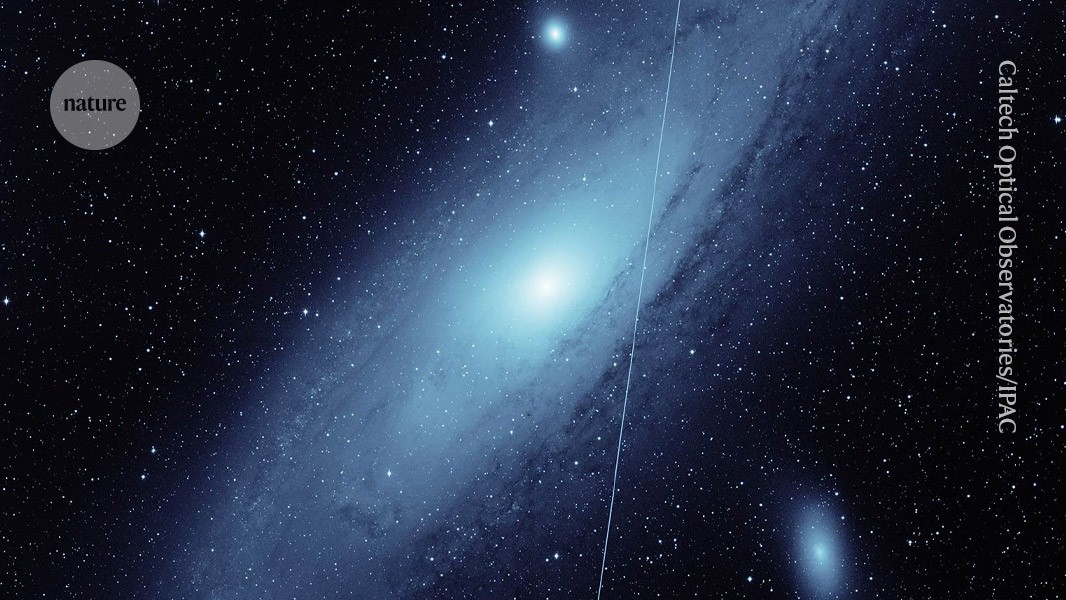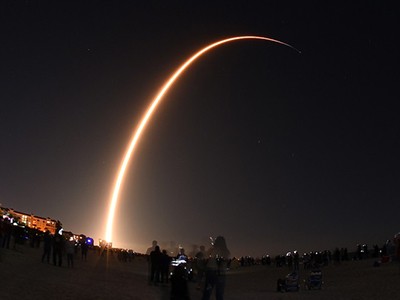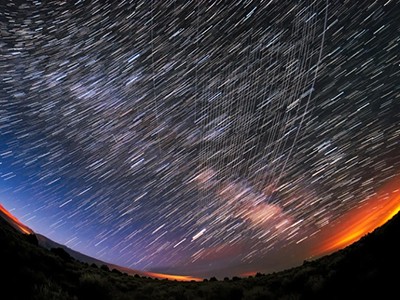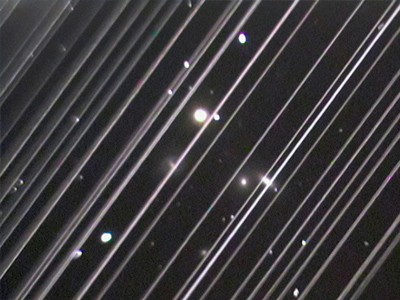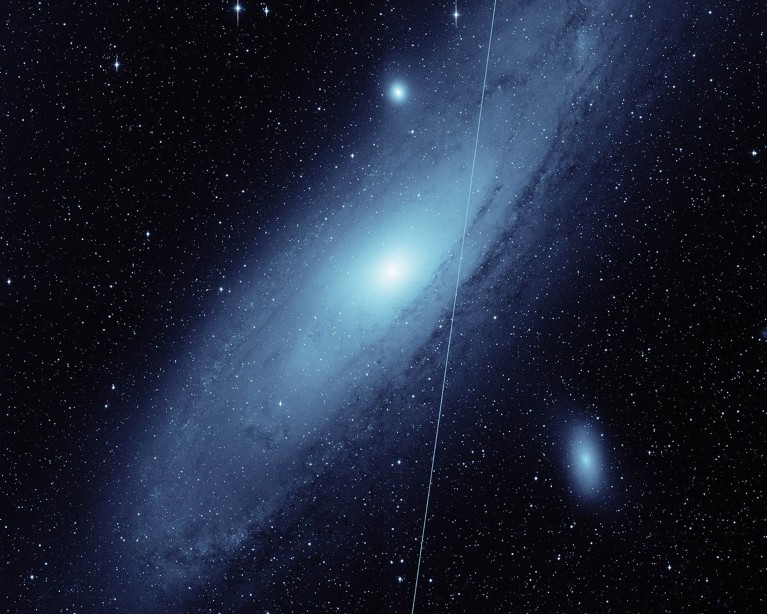
The movement of satellites causes bright stripes in astronomical images.Credit: Caltech Optical Observatories/IPAC
Astronomers have developed a machine-learning algorithm that can detect satellite streaks in images of the night sky with high accuracy. The model makes data easier to interpret and could allow removal of the streaks, which are causing increasing problems in astronomy.
The technology won’t solve the issue of Internet-communications satellites ‘photobombing’ observations, but it could help to reduce their impact on some telescope images. Researchers presented the work at the International Astronomical Union (IAU) general assembly last month in Cape Town.
“Machine learning and artificial intelligence can help because if you have enough data, you can classify that, okay, this is what a satellite looks like,” says Siegfried Eggl, an astrophysicist at the University of Illinois Urbana-Champaign. But satellite launches and developments are moving at “breakneck speed”, he adds, and researchers are “doing our best to catch up”.
Growing threat
Over the past five years, companies including SpaceX in Hawthorne, California, Eutelsat OneWeb in London and Amazon’s Project Kuiper in Redmond, Washington, have launched thousands of communications satellites into low Earth orbit. Many more are planned, including a 12,000-satellite megaconstellation called G60 Starlink, set to be launched by Shanghai Spacecom Satellite Technology in China. “There are now approximately a million satellites in the registry of ambitions for the future,” said Richard Green, director of the IAU’s Centre for the Protection of the Dark and Quiet Sky from Satellite Constellation Interference, in a session at the IAU general assembly.
Astronomers push for global debate on giant satellite swarms
These satellites provide fast broadband Internet access to people worldwide, but are increasingly disruptive for astronomers — they appear as bright streaks in images of the sky and can affect observations across the electromagnetic spectrum. Sensitive telescopes with wide fields of view bear the brunt of this satellite contamination. The upcoming Vera Rubin telescope, for example, could see more than one-third of its images compromised, according to an estimate presented at the assembly.
“Astronomy today is big-data science and there is no person who can look at all of the images that are being recorded every night and detect the streaks,” says Eggl. “This is where machine learning can help.”
To develop a program to identify satellite trails in telescope images, María Romero-Colmenares, a data scientist at the University of Atacama in Chile, trained a supervised machine-learning algorithm on tens of thousands of images taken by a network of telescopes across Chile, Spain, Mexico, Vietnam and South Korea. “We knew what time and position [in the sky] to observe the satellite, and we made one observation with a satellite and one without,” says Romero-Colmenares, generating an equal number of clear and contaminated images. When she and her colleagues applied the model to publicly available data from the WASP (Wide Angle Search for Planets) and Hungarian Automated Telescope Network projects, the algorithm was able to identify 96% of satellite streaks.
‘Unsustainable’: how satellite swarms pose a rising threat to astronomy
Detecting the streaks is an important step towards eliminating them from images and data, says Jeremy Tregloan-Reed, an astrophysicist at the University of Atacama who worked with Romero-Colmenares on the project. The next challenge will be to develop tools that can actually remove the satellite trails while preserving the data underneath. That is possible only in cases where the satellite is not so bright that it saturates an image’s pixels and bleeds into surrounding pixels, Tregloan-Reed says. If bleeding happens, the underlying data cannot be saved.
By the end of next year, the researchers hope to develop an open-source app and program that will enable observatories and amateur astronomers to identify contaminated images and data, and clean them up. Such measures are most likely to succeed for small telescopes that have cameras with low sensitivities.
Star-like flashes
Other forms of satellite contamination are proving even harder to tackle. When solar panels and other flat surfaces on satellites catch the light, they produce flashes resembling short-lived astronomical transients, bursts of energy that can last from milliseconds to years.
“As these flashes are very short, down to a millisecond sometimes, the satellite motion is negligible during it, and we get a perfectly stellar-like flash,” says Sergey Karpov, an astronomer at the Central European Institute for Cosmology and Fundamental Physics in Prague. There is “no real way to distinguish these flashes from astrophysical transients we would like to detect — apart from directly comparing its position to catalogues of satellite orbits”, he adds.
SpaceX tests black satellite to reduce ‘megaconstellation’ threat to astronomy
The electronic equipment inside satellites can also emit unintended radiation that interferes with observations of the Big Bang’s afterglow, says Eggl. Astronomers hope that studying this radiation, known as the cosmic microwave background, will answer questions about the Universe’s expansion. SpaceX’s next-generation satellites, which the company began launching last year, emit around 30 times more radiation than the previous generation. This type of radiation is not regulated and could compromise entire observing bandwidths1.
Eggl points out that AI tools cannot truly recreate lost data, and the problem will get worse as more satellites are launched. “If you brush white paint over the Mona Lisa, at some point, there’s nothing you can do, even if you train a machine learning algorithm on all of da Vinci’s paintings,” Eggl says. “They may guess at what the painting could look like, but they can never reconstruct the data that you lose.”


